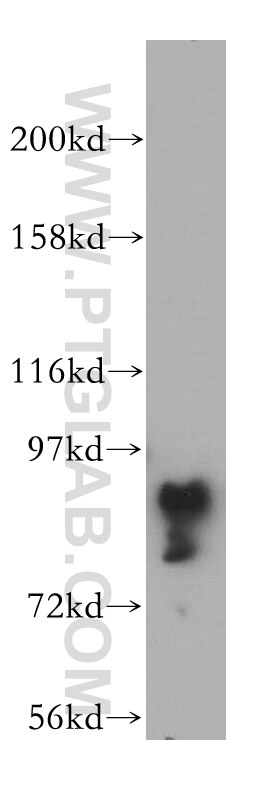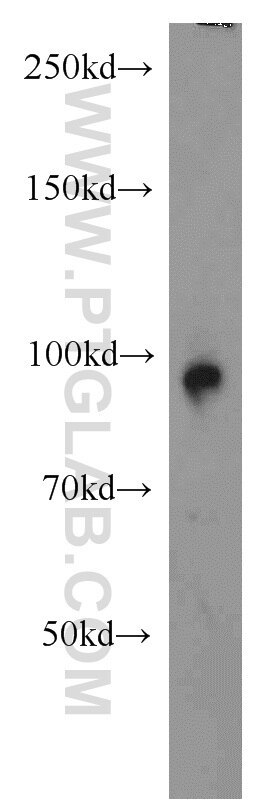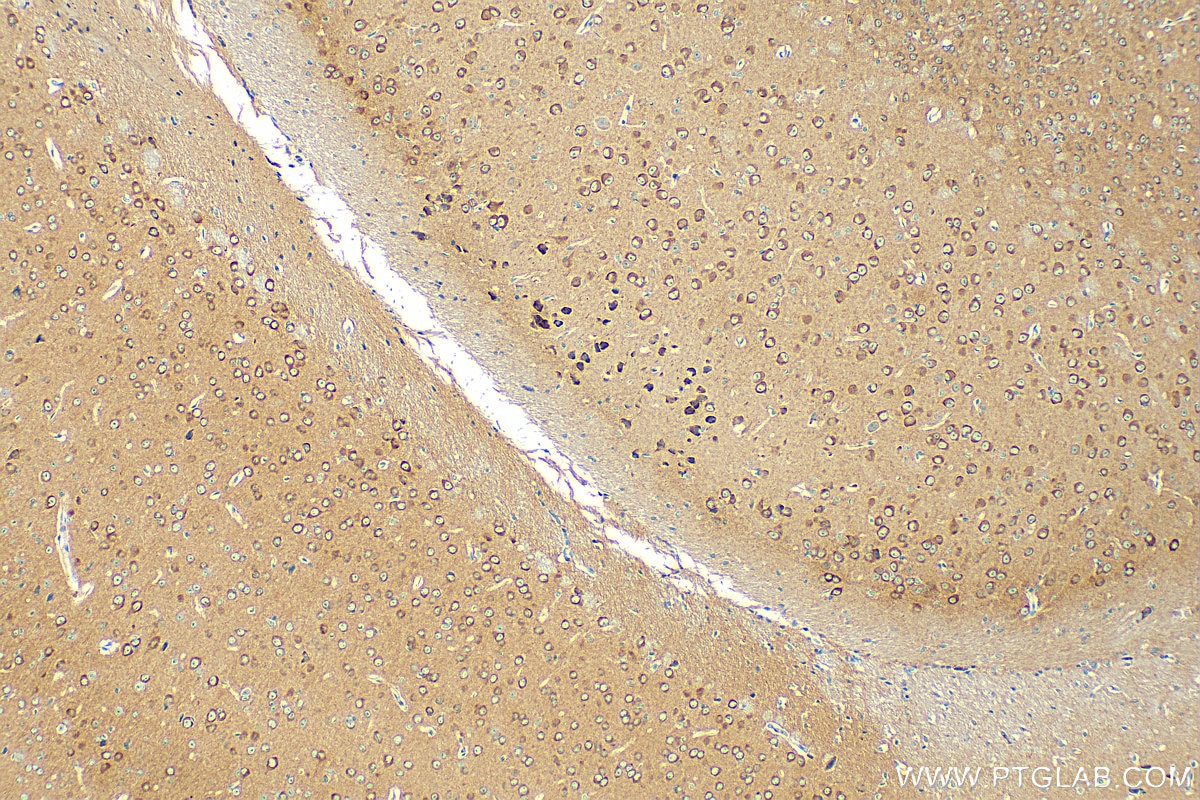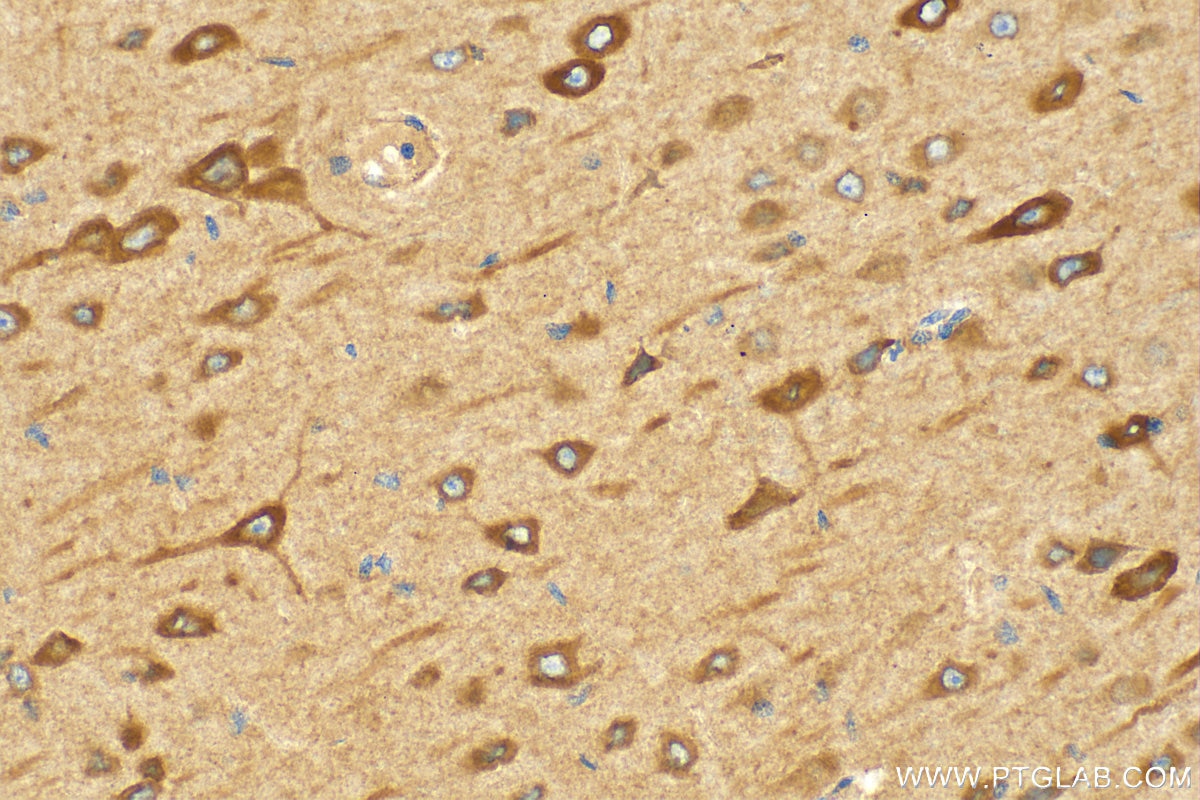Tested Applications
| Positive WB detected in | HeLa cells, HepG2 cells, human brain tissue, mouse thymus tissue |
| Positive IP detected in | HepG2 cells |
| Positive IHC detected in | mouse brain tissue, human heart tissue, human liver tissue, rat brain tissue Note: suggested antigen retrieval with TE buffer pH 9.0; (*) Alternatively, antigen retrieval may be performed with citrate buffer pH 6.0 |
Recommended dilution
| Application | Dilution |
|---|---|
| Western Blot (WB) | WB : 1:500-1:2000 |
| Immunoprecipitation (IP) | IP : 0.5-4.0 ug for 1.0-3.0 mg of total protein lysate |
| Immunohistochemistry (IHC) | IHC : 1:50-1:500 |
| It is recommended that this reagent should be titrated in each testing system to obtain optimal results. | |
| Sample-dependent, Check data in validation data gallery. | |
Published Applications
| WB | See 4 publications below |
| IHC | See 2 publications below |
| CoIP | See 1 publications below |
Product Information
17747-1-AP targets GRAF in WB, IHC, IP, CoIP, ELISA applications and shows reactivity with human, mouse, rat samples.
| Tested Reactivity | human, mouse, rat |
| Cited Reactivity | human, mouse |
| Host / Isotype | Rabbit / IgG |
| Class | Polyclonal |
| Type | Antibody |
| Immunogen |
CatNo: Ag12008 Product name: Recombinant human ARHGAP26 protein Source: e coli.-derived, PGEX-4T Tag: GST Domain: 403-759 aa of BC068555 Sequence: RGINEQGLYRIVGVNSRVQKLLSVLMDPKTASETETDICAEWEIKTITSALKTYLRMLPGPLMMYQFQRSFIKAAKLENQESRVSEIHSLVHRLPEKNRQMLQLLMNHLANVANNHKQNLMTVANLGVVFGPTLLRPQEETVAAIMDIKFQNIVIEILIENHEKIFNTVPDMPLTNAQLHLSRKKSSDSKPPSCSERPLTLFHTVQSTEKQEQRNSIINSSLESVSSNPNSILNSSSSLQPNMNSSDPDLAVVKPTRPNSLPPNPSPTSPLSPSWPMFSAPSSPMPTSSTSSDSSPVSTPFRKAKALYACKAEHDSELSFTAGTVFDNVHPSQEPGWLEGTLNGKTGLIPENYVEFL Predict reactive species |
| Full Name | Rho GTPase activating protein 26 |
| Calculated Molecular Weight | 759 aa, 86 kDa |
| Observed Molecular Weight | 92 kDa |
| GenBank Accession Number | BC068555 |
| Gene Symbol | ARHGAP26 |
| Gene ID (NCBI) | 23092 |
| RRID | AB_2059284 |
| Conjugate | Unconjugated |
| Form | Liquid |
| Purification Method | Antigen affinity purification |
| UNIPROT ID | Q9UNA1 |
| Storage Buffer | PBS with 0.02% sodium azide and 50% glycerol, pH 7.3. |
| Storage Conditions | Store at -20°C. Stable for one year after shipment. Aliquoting is unnecessary for -20oC storage. 20ul sizes contain 0.1% BSA. |
Background Information
GTPase Regulator Associated with Focal Adhesion Kinase (GRAF), also known as Rho GTPase activating protein 26 (ARHGAP26) , is a GTPase-activating protein and inhibits the activity of Rho GTPases by promoting the hydrolytic ability of Rho GTPases. GRAF enhances the hydrolysis of GTPases and converts GTPases from an active form to an inactive form, thereby inhibiting signaling transduction. Deletion and mutation of GRAF can lead to promyelocytic leukemia, suggesting tumor suppressive activity of GRAF. GRAF was downregulated in glioblastoma and associated with cell proliferation and migration (PMID: 10908648, PMID: 17611651, PMID: 31004081). It has been reported that there are three splicing mutants of GRAF, namely GRAF1a (92 kDa),GRAF1b (86 kDa) and GRAF1c (75-82 kDa), and GRAF1b and GRAF1c are the major GRAF1 isoforms in adult brain, whereas GRAF1a is abundant in neonates(PMID: 35624318, PMID: 30626696).
Protocols
| Product Specific Protocols | |
|---|---|
| IHC protocol for GRAF antibody 17747-1-AP | Download protocol |
| IP protocol for GRAF antibody 17747-1-AP | Download protocol |
| WB protocol for GRAF antibody 17747-1-AP | Download protocol |
| Standard Protocols | |
|---|---|
| Click here to view our Standard Protocols |
Publications
| Species | Application | Title |
|---|---|---|
J Neurol Rho GTPase-activating protein 10 (ARHGAP10/GRAF2) is a novel autoantibody target in patients with autoimmune encephalitis | ||
Brain Res Deficiency of NEAT1 prevented MPP+-induced inflammatory response, oxidative stress and apoptosis in dopaminergic SK-N-SH neuroblastoma cells via miR-1277-5p/ARHGAP26 axis. | ||
Cell Death Dis CEMIP, acting as a scaffold protein for bridging GRAF1 and MIB1, promotes colorectal cancer metastasis via activating CDC42/MAPK pathway | ||
World J Surg Oncol Prognostic value of circadian rhythm-associated genes in breast cancer |
Reviews
The reviews below have been submitted by verified Proteintech customers who received an incentive for providing their feedback.
FH Cicek (Verified Customer) (06-11-2024) | I used this antibody on mouse neurons, iPSCs and iNeurons with Western blotting, using beta-actin as positive control. There were specific bands at 90 kDa mark for iPSCs and iNeurons, but not for mouse neurons. It was highly expressed in iNeurons. There were unspecific bands at the 70 kDa mark for all samples.
|




























